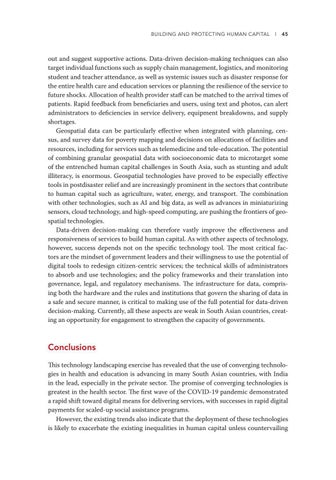Building and Protecting Human Capital l 45
out and suggest supportive actions. Data-driven decision-making techniques can also target individual functions such as supply chain management, logistics, and monitoring student and teacher attendance, as well as systemic issues such as disaster response for the entire health care and education services or planning the resilience of the service to future shocks. Allocation of health provider staff can be matched to the arrival times of patients. Rapid feedback from beneficiaries and users, using text and photos, can alert administrators to deficiencies in service delivery, equipment breakdowns, and supply shortages. Geospatial data can be particularly effective when integrated with planning, census, and survey data for poverty mapping and decisions on allocations of facilities and resources, including for services such as telemedicine and tele-education. The potential of combining granular geospatial data with socioeconomic data to microtarget some of the entrenched human capital challenges in South Asia, such as stunting and adult illiteracy, is enormous. Geospatial technologies have proved to be especially effective tools in postdisaster relief and are increasingly prominent in the sectors that contribute to human capital such as agriculture, water, energy, and transport. The combination with other technologies, such as AI and big data, as well as advances in miniaturizing sensors, cloud technology, and high-speed computing, are pushing the frontiers of geospatial technologies. Data-driven decision-making can therefore vastly improve the effectiveness and responsiveness of services to build human capital. As with other aspects of technology, however, success depends not on the specific technology tool. The most critical factors are the mindset of government leaders and their willingness to use the potential of digital tools to redesign citizen-centric services; the technical skills of administrators to absorb and use technologies; and the policy frameworks and their translation into governance, legal, and regulatory mechanisms. The infrastructure for data, comprising both the hardware and the rules and institutions that govern the sharing of data in a safe and secure manner, is critical to making use of the full potential for data-driven decision-making. Currently, all these aspects are weak in South Asian countries, creating an opportunity for engagement to strengthen the capacity of governments.
Conclusions This technology landscaping exercise has revealed that the use of converging technologies in health and education is advancing in many South Asian countries, with India in the lead, especially in the private sector. The promise of converging technologies is greatest in the health sector. The first wave of the COVID-19 pandemic demonstrated a rapid shift toward digital means for delivering services, with successes in rapid digital payments for scaled-up social assistance programs. However, the existing trends also indicate that the deployment of these technologies is likely to exacerbate the existing inequalities in human capital unless countervailing

